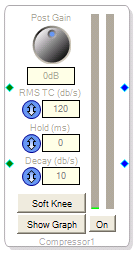RMS (Display)
Controls
| Post Gain |  | Post-processing gain, for increasing the overall signal level following dynamics processing. |
| RMS TC (db/s) |  | Controls the time constant (TC) in dB/second that is used for calculating the RMS input value. The time constant determines how rapidly the compressor will respond to input signal level changes, e.g. the “Attack” time. |
| Hold (ms) |  | Controls the time (in ms) the compressor maintains its current output gain setting before it starts decreasing as the input level decrease. |
| Decay (db/s) |  | Controls the rate at which the compressor gain decreases in response to decrease in the input signal level, e.g. the “Release” time. |
| Soft Knee |  | Soft-knee lets the compressor ease into action, making a less-abrupt change from unprocessed signal to compressed signal. Typically it sounds better. If it is not activated, the default is hard-knee behavior, meaning compression reduces signal level immediately when the threshold is passed. |
| Show Graph |  | Opens the Compression Curve editor window. |

 This block functions exactly like RMS (gain) with the Stereo 1 RMS algorithm, except that it comes with a signal level display.
This block functions exactly like RMS (gain) with the Stereo 1 RMS algorithm, except that it comes with a signal level display.